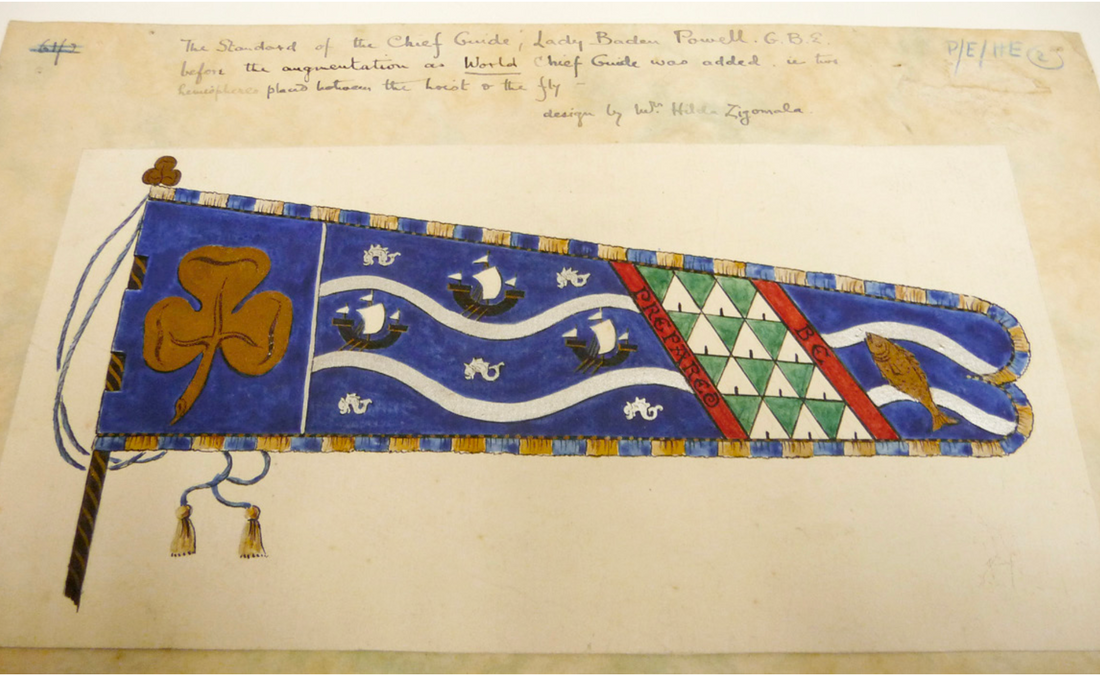
GUIDING LIGHT: RACHEL KAY-SHUTTLEWORTH AND THE GIRL GUIDES

Image: Standard design for the North East Lancashire Guide. Image above: Standard design for Lady Baden Powell’s Guide.
The Scouting Movement had only recently begun in 1907. Although designed only for boys, when Baden Powell held the first Scout conference at Crystal Palace in 1909, he was surprised to see more than 2000 girls there who liked the idea and had organised themselves. With no official organisation for girls, there was no official uniform until the Scout Magazine, on July 10th 1909, offered an article including instructions for a uniform for girl Scouts: ’a modified gymslip similar to the following: scarlet biret [sic], haversack, jersey and short skirt, (both dark blue), belt, light staff, stockings (pulled up over the knees).’
In 1910 under the tutelage of Agnes Baden Powell, younger sister to Robert Baden Powell, the Girl Guides were formed, named for the famous frontier troops in India who could rise to any challenge that came their way. From the outset, the intention of the Girl Guide movement was serious education and service: “They wear a uniform, and are divided into patrols and troops like Boy Scouts and can win badges and medals in very much the same way. But all the time, they will be doing useful jobs... by which they will be of real value to their country in time of need, instead of merely imitating the boys and amusing themselves at scouting.” –a radical view, especially as Edwardian views of female conduct were so extreme that one young lady wrote to The Scout Magazine in November 1909 asking: ‘If a girl is not allowed to run, or even to hurry, to swim, ride a bike or raise her arms above her head. Can she become a Scout?’ Girl Guides learnt the domestic arts, childcare, first aid and nursing and how to cope in an emergency. Such shared values must have been irresistible to Kay-Shuttleworth, who was already heavily involved in war work, ensuring that children were evacuated safely. She set up her troop in Padiham, becoming the first County Commissioner for the Girl Guides Association in Lancashire in 1916. She remained dedicated to the association for over 30 years, actively promoting the movement and driving membership garnering the organisation’s highest honour, the Silver Fish. She founded new troops, educated their leaders, and made Gawthorpe Hall a delightful destination for Guide rallies and campouts, giving many girls their happiest childhood memories.

Image: Rachel B. Kay-Shuttleworth and Lady Cochrane (right) with a Guide standard between them.
Known always fondly as Miss Rachel, she was devoted to teaching the Guides needlework and handicrafts to give them valuable skills for life that would also give them great pleasure. She became the Girl Guides’ first Heraldry Advisor when she conceived of using heraldic standards to rally and represent the Guides. In her article ‘Girl Guide Standards’ for the Girl Guides Gazette, appearing in the December 1920 issue: “The Art of Heraldry can be of use to the Guides in several ways: Symbolically, our standards and badges remind us of our promises and bring them into the sight and understanding of others; Historically, by heraldic means, achievements can be recorded, and noble traditions commemorated; Decoratively, heraldry adorns employing bright colours, handsome design and various ornament. Thus, The Guides can brighten much that today is chill and drear and bring into life some of the glow of art and tradition that throbbed through Merrie, England. Standards set before us will strengthen us in unity and continually inspire us to stand together doing our duty to God and the King, helping others at all times and obeying the Guide Law.”
Image: Image above right: Sampler designed by Rachel B. Kay-Shuttleworth for Helen Taylor in 1923, “The Girl Guides of North East Lancashire made this as a token of affection and an appreciation of Miss Helen Taylor who as County Secretary, Camp Advisor of the First Habergham Company and in many other capacities gave most able, loyal and cheerful service to the Guides and the County from 1918 to 1923.”In the smoke coming from the fire is a paraphrasing of the original Guide promise which I think reads “Loyal to God & King, Obey the Guide Laws.”
Providing such powerful inspiration, she ended the piece with the assurance that: ‘any Company or County desiring to make a standard is invited to send questions regarding the designing and making of standards’ to her at Gawthorpe Hall with only the need of a stamped addressed envelope for a reply. Always as good as her word, Miss Rachel worked on many of them, most famously the North East Lancashire standard adorned with the Victorian motto from above the door at Gawthorpe meaning “friendship and family endures,” and she advised on many more. She also embroidered a standard for Princess Mary, President of the Girl Guide Association, and presented it to her at her wedding at Westminster Abbey in 1920.
Image above: Rachel B. Kay-Shuttleworth (1886-1967).
Within the Gawthorpe Textiles Collection is a sampler designed by Miss Rachel, featuring a campfire, flags and tents; it embodies the Girlguiding spirit, and as all the Guides and Brownies in the area contributed at least one stitch, it is a unique testimony to her legacy.
Read more about the legacy of the textile industry in Lancashire in Selvedge issue 114: Regeneration.
